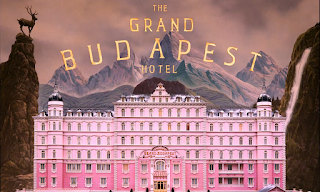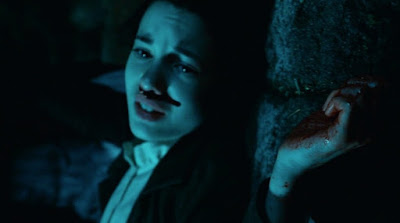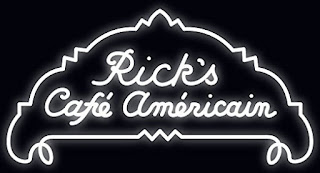Film Analysis - ' The Grand Budapest Hotel' (Directed by Wes Anderson)
 The film ‘The Grand Budapest Hotel’ (directed by Wes
Anderson) is a master piece set primarily in 1932 that makes exquisite use of
Mr Anderson’s filming technique of keeping everything in the shot centred, this
helps to create a uniqueness that lingers in every scene of the 1 hour and 40
minute film. The films plot features two main characters, Mr Gustav H (The
hotel’s concierge) and Zero (the hotel’s lobby boy), these protagonists are
both quirky in character and possess a sort of profound honesty that separates
them from the protagonists of other films. The story truly begins once it is
revealed that Gustav’s lover, an elderly rich woman has perished and has suddenly
written him into her will as the owner of a priceless painting called ‘Boy with
Apple’, this cause discord within her still living distant and close relatives,
especially her son who declares that the painting will not be taken by anyone
other than he. The majority of the plot consists of the curious antics and
catastrophes that follow this sudden change in the will; however the plot of
the film is not what makes it such an impressive watch, rather it is the
development of the characters that truly shines, you as the viewer becomes
almost addicted to the exchanges shared between the protagonists and side
characters alike, every scene possesses a sense of purpose and quirky refinement
which ultimately puts this film in a class of its own. The characters of both
Gustav and Zero contrast greatly, Gustav being a privileged white hotel concierge
whilst Zero is a poor refugee who has suffered greatly because of the war that
is constantly referenced throughout the movie, however these two protagonists,
whilst both completely different, convey a sort of wordless connection that
allows them to have fluid conversations that do not fit in normal conventions
yet somehow still manage to work perfectly, humorously even. There is never a
true sense of safety in this film however as even during its most light hearted
scenes, there is still the underlying threat that is presented by warfare and
civil conflict; this changes the dynamic of the story occasionally and unfairly
forces the characters to undertake less then preferable actions and ultimately
conveys the maliciousness of war extremely well to the audience who grows more
fearful for the protagonists well beings every time conflict is referenced.
The film ‘The Grand Budapest Hotel’ (directed by Wes
Anderson) is a master piece set primarily in 1932 that makes exquisite use of
Mr Anderson’s filming technique of keeping everything in the shot centred, this
helps to create a uniqueness that lingers in every scene of the 1 hour and 40
minute film. The films plot features two main characters, Mr Gustav H (The
hotel’s concierge) and Zero (the hotel’s lobby boy), these protagonists are
both quirky in character and possess a sort of profound honesty that separates
them from the protagonists of other films. The story truly begins once it is
revealed that Gustav’s lover, an elderly rich woman has perished and has suddenly
written him into her will as the owner of a priceless painting called ‘Boy with
Apple’, this cause discord within her still living distant and close relatives,
especially her son who declares that the painting will not be taken by anyone
other than he. The majority of the plot consists of the curious antics and
catastrophes that follow this sudden change in the will; however the plot of
the film is not what makes it such an impressive watch, rather it is the
development of the characters that truly shines, you as the viewer becomes
almost addicted to the exchanges shared between the protagonists and side
characters alike, every scene possesses a sense of purpose and quirky refinement
which ultimately puts this film in a class of its own. The characters of both
Gustav and Zero contrast greatly, Gustav being a privileged white hotel concierge
whilst Zero is a poor refugee who has suffered greatly because of the war that
is constantly referenced throughout the movie, however these two protagonists,
whilst both completely different, convey a sort of wordless connection that
allows them to have fluid conversations that do not fit in normal conventions
yet somehow still manage to work perfectly, humorously even. There is never a
true sense of safety in this film however as even during its most light hearted
scenes, there is still the underlying threat that is presented by warfare and
civil conflict; this changes the dynamic of the story occasionally and unfairly
forces the characters to undertake less then preferable actions and ultimately
conveys the maliciousness of war extremely well to the audience who grows more
fearful for the protagonists well beings every time conflict is referenced. Wes Anderson has a critically acclaimed style about his work
that ultimately makes up most of his creations, he has a personal sweet spot for
(intentionally crude) stop frame animation and changing the film ratios.
Throughout the movie film Ratios change dependent on what is occurring in the
scene, occasionally changing from 4.3 to 2.35, Mr Anderson loves doing this as
it suits his desire to keep everything centred and looking as though it was
made using older, more passionate forms of film making.
Wes Anderson has a critically acclaimed style about his work
that ultimately makes up most of his creations, he has a personal sweet spot for
(intentionally crude) stop frame animation and changing the film ratios.
Throughout the movie film Ratios change dependent on what is occurring in the
scene, occasionally changing from 4.3 to 2.35, Mr Anderson loves doing this as
it suits his desire to keep everything centred and looking as though it was
made using older, more passionate forms of film making.
Personally I love this film, it strays away from normal
conventions and attempts to be something entirely new, emotionally, creatively
and aesthetically; Wes Anderson has a style about his work that defines his
creations more than the recycled corporate films that dominate the filming
industry in these times. I genuinely wanted to know what happens next in the
plot and I held on to each moment wishing that the movie wouldn’t end simply
because there are no other films that could fill the void this one left behind
once it was finished, that is the true weapon this film possesses, it is so
damnably original that it cannot be replaced or looked over.




Comments
Post a Comment